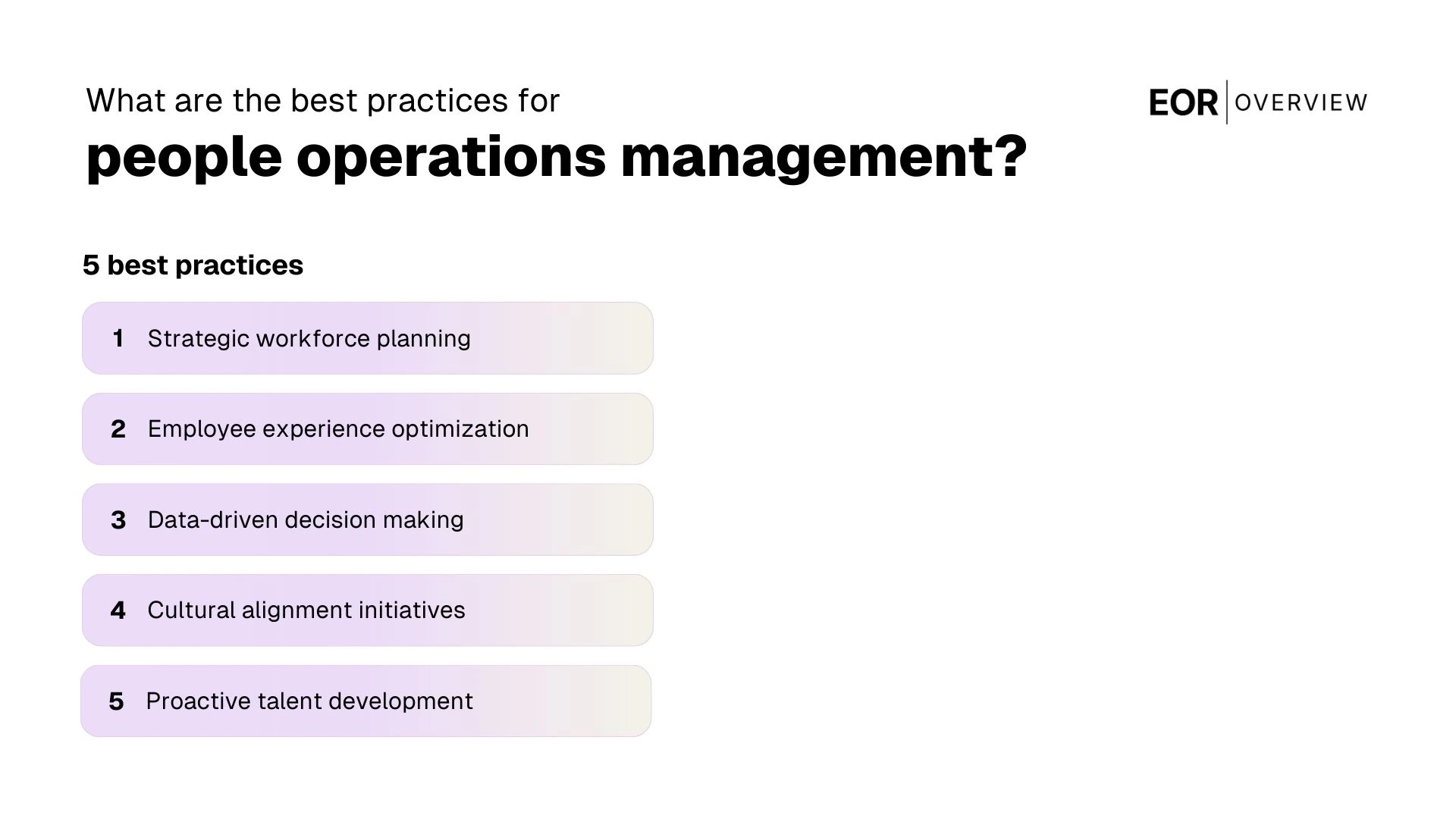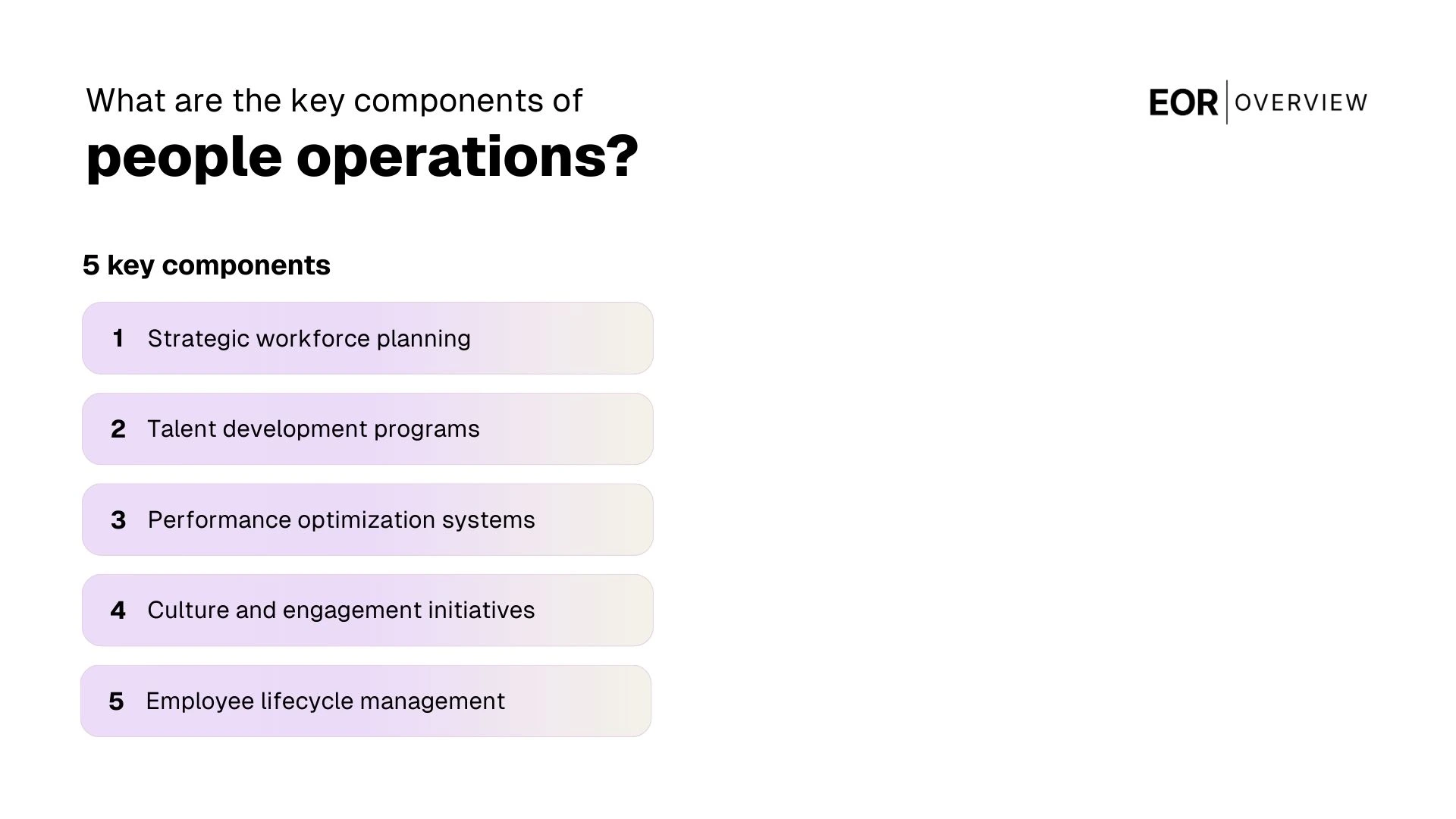People operations is a strategic approach to human resources that focuses on creating systems, processes, and cultures that enable employees to do their best work while driving organizational success.
For HR managers and hiring leaders in tech, finance, and startup environments, people operations represents a shift from reactive problem-solving to proactive people strategy. This approach helps you build scalable processes that support rapid growth, improve employee experience, and create competitive advantages through your workforce. As organizations compete for top talent in increasingly complex markets, those who master people operations gain significant advantages in attraction, retention, and performance.
Companies with strong people operations practices report significantly higher employee engagement scores and are better positioned to scale their teams effectively during periods of rapid growth.
The people ops team acts as strategic partners who design systems and processes that help organizations attract, hire, develop, and retain top talent. A people operations manager typically combines data-driven insights with human-centered design to solve workplace challenges and enhance the overall employee experience.
This evolution from traditional HR reflects the changing needs of modern workplaces, particularly in tech, finance, and startup environments. People operations emphasizes proactive problem-solving rather than reactive administration, using technology and analytics to predict and address employee needs before they become issues.
The fundamental shift involves moving from policy enforcement to experience optimization. People ops professionals focus on creating seamless workflows, improving communication channels, and building cultures that support both individual growth and organizational success.
How does people operations differ from traditional HR?
The distinction between traditional human resources and a modern people operations department lies in their strategic approach and scope of influence. While traditional HR teams focus on administrative tasks like payroll, compliance, and policy enforcement, people operations takes a more holistic view of the employee experience from recruitment through career development.
A director of people operations typically oversees initiatives that directly impact business outcomes, such as designing scalable onboarding processes that reduce time-to-productivity and implementing data-driven retention strategies. The people operations team works closely with leadership to align people strategy with business objectives, rather than simply responding to HR requests.
The key responsibilities of a people operations specialist extend beyond traditional HR functions to include workforce analytics, employee engagement measurement, and company culture development. This approach is particularly valuable in tech and finance companies where remote work and rapid scaling demand innovative best practices for managing distributed teams.
Transform your traditional hr team into a people operations powerhouse by implementing quarterly workforce analytics reviews that measure employee satisfaction, productivity metrics, and retention rates across different departments and workplace arrangements.
What does people operations do?
People operations serves as the strategic backbone of modern organizations, transforming the traditional hr department into a comprehensive function that drives business success through putting people first. This evolved approach goes beyond administrative tasks to create meaningful employee experiences that fuel growth and innovation.
The responsibilities of a people operations team span five core areas that directly impact your organization's ability to attract, develop, and retain top talent in today's competitive landscape.
Talent acquisition and onboarding: Streamlines the entire hiring process from job posting to first-day integration, ensuring new hires feel welcomed and prepared to contribute immediately to the team's success.
Employee development and career growth: Creates comprehensive training and development programs that align individual aspirations with business objectives, fostering continuous learning and internal mobility opportunities.
Performance management and feedback systems: Implements data-driven performance management frameworks that provide regular coaching, goal setting, and recognition to maximize individual and team productivity.
Culture and engagement initiatives: Designs strategic employee engagement programs that strengthen organizational culture, boost morale, and create a sense of belonging across all levels of the organization.
Compensation and benefits optimization: Develops competitive compensation structures and comprehensive benefits packages that attract top talent while maintaining budget efficiency and regulatory compliance.
How people operations practically functions?
People operations functions as the strategic backbone that connects hr practices with business goals through systematic coordination across multiple touchpoints. A people ops specialist orchestrates this process by establishing workflows that span from talent acquisition to performance management, ensuring each component supports organizational objectives.
The people ops approach begins with talent pipeline management, where specialists collaborate with hiring managers to identify and attract top talent that aligns with company culture and technical requirements. This process extends beyond recruitment to encompass onboarding workflows that integrate new employees into existing systems while establishing clear performance expectations from day one.
Operational execution involves managing interconnected systems that handle payroll, benefits administration, and compliance tracking through centralized platforms. The entire people operations framework relies on data-driven insights to monitor employee performance trends, identify retention risks, and optimize resource allocation across departments.
Modern people ops teams leverage technology integrations that automate routine tasks while maintaining human oversight for strategic decisions. This hybrid approach allows organizations to scale their workforce management capabilities without compromising the personalized experience that drives employee engagement and productivity.
What is the people operations employee life cycle?
The people operations employee life cycle represents a comprehensive, data-driven approach that extends beyond traditional hr practices to create meaningful employee experiences. Unlike conventional hr processes that focus primarily on administrative tasks, people operations takes a people-centric view that encompasses every touchpoint from recruitment through offboarding.
This strategic framework enables organizations to oversee the entire employee journey through five interconnected stages: attraction and recruitment, onboarding and integration, development and engagement, retention and growth, and transition and offboarding. Each phase requires careful coordination between the human resources department and other stakeholders to ensure seamless experiences.
Modern people operations teams leverage technology and analytics to maintain comprehensive hr records while tracking employee satisfaction, performance metrics, and engagement levels throughout each lifecycle stage. This holistic approach falls under the broader hr umbrella but distinguishes itself through its emphasis on employee experience optimization rather than purely administrative functions.
Map out your current employee touchpoints and identify gaps where data-driven insights could improve the experience. Focus on moments that matter most to employees, such as their first week, performance reviews, and career transitions.
The department and the roles of people operations
People operations departments function as the strategic backbone that supports the entire employee life cycle, from recruitment through retirement. Unlike traditional HR, the term people operations encompasses a more proactive approach to keeping your staff happy and engaged throughout their journey with your organization.
Modern people ops teams typically include hr partners, employee experience specialists, talent acquisition managers, and data analysts who work together to create seamless employee experiences. These roles are designed to support every stage of the employee journey while maintaining focus on strategic business outcomes.
Business partners: Strategic advisors who align people initiatives with company goals and work directly with leadership teams to drive organizational success.
Employee experience specialists: Professionals who design and optimize touchpoints throughout the employee lifecycle, ensuring staff happy and healthy outcomes.
Talent acquisition managers: Experts who focus on attracting and onboarding new hires while building sustainable recruitment processes.
People analytics specialists: Data-driven professionals who collect and analyze employee feedback to inform strategic decisions and improve workplace culture.

What are the best practices for people operations management?
The most effective people operations management practices focus on strategic workforce planning, employee experience optimization, data-driven decision making, cultural alignment, and proactive talent development. These practices transform traditional reactive HR approaches into forward-thinking strategies that drive business outcomes. These best practices are detailed below to help you build a comprehensive people operations framework.
Strategic workforce planning: Move beyond reactive hiring by analyzing future talent needs and identifying key priorities for organizational growth. This approach helps teams anticipate staffing requirements rather than scrambling to fill urgent gaps.
Employee experience optimization: Focus on onboarding new employees with structured programs that integrate them into your workplace culture within the first 90 days. The term was coined by Laszlo Bock to emphasize treating employees as customers of the HR function.
Data-driven decision making: Use analytics to track employee engagement, retention rates, and performance metrics. This enables evidence-based strategies to enhance employee satisfaction and productivity across tech, finance, and startup environments.
Cultural alignment initiatives: Develop programs that reinforce company values through regular feedback sessions, recognition systems, and leadership development opportunities that strengthen workplace culture.
Proactive talent development: Create career progression pathways and skill-building programs that prepare employees for future roles while addressing current business needs.
How to effectively transition from traditional HR to people operations?
The transition from traditional HR to people operations requires a fundamental shift in mindset and approach. Start by implementing strategies that focus on employee experience rather than just compliance and administrative tasks. This transformation positions your team as strategic partners who directly contribute to the overall mission of the organization.
The primary transformation areas include talent development, data-driven decision making, employee engagement, and strategic workforce planning. These areas form the foundation of a successful people operations approach.
Talent development focus: Shift from generic training programs to personalized individual development plans that align with both employee aspirations and business objectives.
Data-driven insights: Use analytics to track metrics like absenteeism, engagement scores, and retention rates to make informed decisions about workforce strategies.
Employee experience design: Create initiatives that promote better work-life balance and address the holistic needs of your workforce.
Strategic partnership: Redefine your primary responsibilities to include business consulting, organizational design, and culture development rather than just policy enforcement.
Start your transition by identifying one high-impact area where you can demonstrate measurable business value. Success in a focused area builds credibility for broader people operations initiatives across the organization.

What are the key components of people operations?
People operations encompasses strategic workforce management, talent development, performance optimization, culture building, and compliance oversight to ensure employees are engaged and productive throughout their entire journey with the organization. These components work together to create a people-first approach that drives business success.
These key components are listed in detail below.
Strategic workforce planning: Aligns hiring strategies with business objectives to ensure the right talent is in place for current and future needs.
Talent development programs: Creates comprehensive learning pathways that enhance employee skills and prepare high-potential individuals for leadership roles.
Performance optimization systems: Implements data-driven approaches to measure and improve employee productivity while identifying areas for growth and recognition.
Culture and engagement initiatives: Develops programs that foster belonging, collaboration, and alignment with company values to keep the entire people ecosystem thriving.
Employee lifecycle management: Streamlines processes from recruitment through onboarding support, career progression, and eventual transitions to ensure consistent experiences.
Modern people operations teams leverage technology platforms to automate routine tasks while focusing on strategic initiatives that directly impact employee satisfaction and business outcomes. This approach enables organizations to scale their people-first culture as they grow.
Why is people operations important today?
People operations has become critical in today's competitive talent market because it takes a fundamentally different approach to hr that prioritizes strategic workforce planning over administrative tasks. Unlike traditional HR departments, people operations oversees the entire people lifecycle with an employee-centric focus that directly supports the company's goals.
Modern organizations recognize that people operations may be their greatest competitive advantage when it comes to building a strong company culture and maintaining high employee satisfaction. This strategic function helps companies cultivate environments where employees thrive, leading to better performance and innovation outcomes.
The importance becomes even more apparent when considering talent retention challenges. People operations focuses on improving employee experiences through structured career development programs and clear career progression pathways. Effective internal communications and development initiatives help organizations retain talent by demonstrating genuine investment in their workforce's future.
Organizations that treat people operations as simply rebranded HR risk missing the strategic transformation needed to compete for top talent in today's market.

